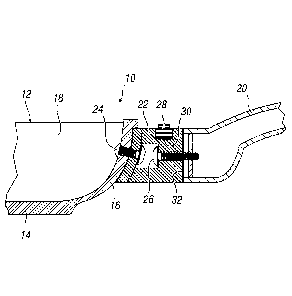Some of the information on this Web page has been provided by external sources. The Government of Canada is not responsible for the accuracy, reliability or currency of the information supplied by external sources. Users wishing to rely upon this information should consult directly with the source of the information. Content provided by external sources is not subject to official languages, privacy and accessibility requirements.
Any discrepancies in the text and image of the Claims and Abstract are due to differing posting times. Text of the Claims and Abstract are posted:
| (12) Patent Application: | (11) CA 3126994 |
|---|---|
| (54) English Title: | VESSEL FOR COOKING FOOD PROVIDED WITH A THERMAL SIGNALING DEVICE |
| (54) French Title: | RECIPIENT POUR CUIRE DES ALIMENTS COMPRENANT UN DISPOSITIF DE SIGNALEMENT THERMIQUE |
| Status: | Examination |
| (51) International Patent Classification (IPC): |
|
|---|---|
| (72) Inventors : |
|
| (73) Owners : |
|
| (71) Applicants : |
|
| (74) Agent: | ROBIC AGENCE PI S.E.C./ROBIC IP AGENCY LP |
| (74) Associate agent: | |
| (45) Issued: | |
| (22) Filed Date: | 2021-08-06 |
| (41) Open to Public Inspection: | 2022-03-01 |
| Examination requested: | 2024-04-17 |
| Availability of licence: | N/A |
| Dedicated to the Public: | N/A |
| (25) Language of filing: | English |
| Patent Cooperation Treaty (PCT): | No |
|---|
| (30) Application Priority Data: | ||||||
|---|---|---|---|---|---|---|
|
A vessel (10) for cooking food is described, comprising a body (12)
which in turn comprises a bottom wall (14) and at least one side wall (16).
The side wall (16) extends from the bottom wall (14) to define an inner space
(18) of the vessel (10) where food is placed in order for it to be cooked. The
vessel (10) for cooking food also comprises at least one handle (20), made
from a first metal material, preferably steel, and bound to a portion of the
body (12) through the interposition of at least one connection element (22)
made from a second metal material, preferably aluminum. The coefficient of
thermal conductivity of the second metal material, which the connection
element (22) is made from, is greater than the coefficient of thermal
conductivity of the first metal material, which the handle (20) is made from.
The connection element (22) is operationally connected to at least one
thermal signaling device (28).
Note: Claims are shown in the official language in which they were submitted.
Note: Descriptions are shown in the official language in which they were submitted.

2024-08-01:As part of the Next Generation Patents (NGP) transition, the Canadian Patents Database (CPD) now contains a more detailed Event History, which replicates the Event Log of our new back-office solution.
Please note that "Inactive:" events refers to events no longer in use in our new back-office solution.
For a clearer understanding of the status of the application/patent presented on this page, the site Disclaimer , as well as the definitions for Patent , Event History , Maintenance Fee and Payment History should be consulted.
| Description | Date |
|---|---|
| Maintenance Fee Payment Determined Compliant | 2024-08-02 |
| Maintenance Request Received | 2024-08-02 |
| Letter Sent | 2024-04-18 |
| Request for Examination Received | 2024-04-17 |
| Amendment Received - Voluntary Amendment | 2024-04-17 |
| All Requirements for Examination Determined Compliant | 2024-04-17 |
| Amendment Received - Voluntary Amendment | 2024-04-17 |
| Request for Examination Requirements Determined Compliant | 2024-04-17 |
| Application Published (Open to Public Inspection) | 2022-03-01 |
| Inactive: Cover page published | 2022-02-28 |
| Common Representative Appointed | 2021-11-13 |
| Letter sent | 2021-11-10 |
| Correct Applicant Requirements Determined Compliant | 2021-11-10 |
| Filing Requirements Determined Compliant | 2021-11-10 |
| Inactive: Filing certificate correction | 2021-09-14 |
| Inactive: IPC assigned | 2021-09-03 |
| Inactive: IPC assigned | 2021-09-03 |
| Inactive: First IPC assigned | 2021-09-03 |
| Priority Claim Requirements Determined Compliant | 2021-08-31 |
| Letter sent | 2021-08-31 |
| Request for Priority Received | 2021-08-31 |
| Filing Requirements Determined Compliant | 2021-08-31 |
| Inactive: QC images - Scanning | 2021-08-06 |
| Common Representative Appointed | 2021-08-06 |
| Application Received - Regular National | 2021-08-06 |
| Inactive: Pre-classification | 2021-08-06 |
There is no abandonment history.
The last payment was received on 2024-08-02
Note : If the full payment has not been received on or before the date indicated, a further fee may be required which may be one of the following
Please refer to the CIPO Patent Fees web page to see all current fee amounts.
| Fee Type | Anniversary Year | Due Date | Paid Date |
|---|---|---|---|
| Application fee - standard | 2021-08-06 | 2021-08-06 | |
| MF (application, 2nd anniv.) - standard | 02 | 2023-08-08 | 2023-07-28 |
| Request for examination - standard | 2025-08-06 | 2024-04-17 | |
| MF (application, 3rd anniv.) - standard | 03 | 2024-08-06 | 2024-08-02 |
Note: Records showing the ownership history in alphabetical order.
| Current Owners on Record |
|---|
| ZWILLING BALLARINI ITALIA S.R.L. |
| Past Owners on Record |
|---|
| FRANCESCO FERRON |